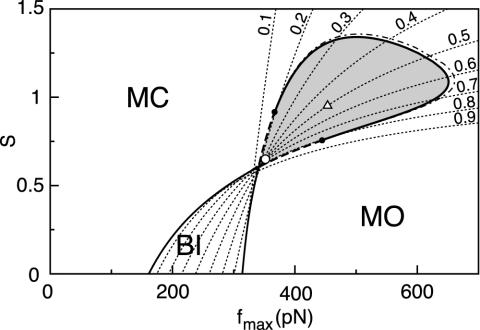Fig. 1.
State diagram of a hair bundle as a function of the maximal force fmax that adaptation motors produce and of the strength S of Ca2+ feedback on motor activity. Lines of equal open probability Po of the transduction channels (dotted lines) are superimposed and each are indexed by the corresponding value for Po. The diagram is parsed into regions in which the hair bundle can be monostable with transduction channels mostly closed (MC) or mostly open (MO), bistable (BI), or oscillatory (gray). Hopf bifurcations occur along the line separating oscillating from stable states: for small fmax, the bifurcation is subcritical (broken line), whereas the bifurcation becomes supercritical for larger motor forces (solid line). For fmax = 352 pN and S = 0.65 with Po = 0.5 (○), stochastic simulations of the system closely matched the behavior of a hair bundle that was studied experimentally (see Figs. 2 and 3). For fmax = 439 pN and Po = 0.5 (▵), the noisy system displayed a global maximum of sensitivity to small stimuli (see Fig. 4). The quality factor of the bundle's spontaneous oscillations was also close to the global maximum there. The state diagram was calculated by assuming that the calcium dynamics is instantaneous τ = 0. In the case of τ = 0.1 ms, the oscillatory region expands slightly toward regions of larger motor forces (dot-dash line). Parameters used are listed in Table 1.

